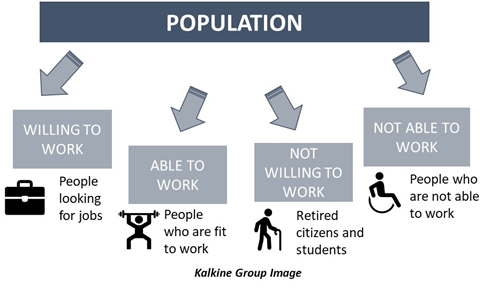What is Full Employment?
Full employment refers to the state when every individual in the economy who is willing and able to work is employed. The employed workforce does not include senior citizens and students, as they are not willing to work. It may also exclude the personnel that are not physically fit to work.
It can also be understood as a situation where there is no involuntary unemployment. Under full employment, all resources in the economy are fully utilised. Efficient use of resources would enable the economy to reach the maximum level of output attainable by it.
However, According to Keynes, full employment refers to that state when an increase in aggregate demand does not lead to a rise in the level of employment and output. Keynes also states that there would ideally never be full employment in the economy, due to a certain level of voluntary unemployment always being present in it.
A full employment scenario occurs when the economy functions on the Production Possibility Curve and not below it. Every point on the PPF curve represents an efficient production level, where the resources are fully utilised.

How do economies reach full employment?
Full employment is not a situation that can be practically observed. There always exists some level of unemployment in the economy. There can be many reasons for an economy to have unemployment. Based on these reasons, unemployment can be classified into the following types:
- Frictional Unemployment: Frictional unemployment occurs due to the working population shifting jobs. When employed individuals want a change in their career, they might take a sabbatical from work, or stay at home to look for a new job.
- Cyclical Unemployment: This type of unemployment occurs during the economic downturns in the business cycle. It might become severe during a recession, and it declines during a period of economic growth.
- Structural Unemployment: It occurs due to technological changes which might lead to specific manual jobs becoming obsolete. As newer technology arrives in the market, people might lose out on their jobs.
- Institutional Unemployment: It can occur because of unfavourable government policies, labour market phenomena and other institutional decisions that might lead to individuals losing their jobs.
Many of these unemployment types are caused by external factors that are beyond the control of individuals. External factors like government policies, technological developments, and business cycle downturns end up hurting the availability of jobs in the market. Even if all the elements in the economy are favourable, individuals might be in between jobs, making them frictionally unemployed.
It becomes difficult to break down which type of unemployment might be prevalent if there are no clear market indicators. It is safe to say that most of these factors are hard to avoid or eliminate. However, once the government realises that there is unemployment in the economy, they can provide relief packages to unemployed people.
Full employment can be understood as the “optimal level” of employment when unemployment is not 0, but there are no involuntarily unemployed people. Frictional unemployment may cause the unemployment rate to stay at around 2-3%. Thus, an unemployment rate of less than 3% is targeted by many economies to establish full employment in the economy.
What is meant by NAIRU?
NAIRU refers to the Non-Accelerating Inflation of Unemployment, which is the threshold to measure the level of unemployment. It is calculated by taking the historical relationship between the unemployment rate and any changes in inflation.
If the unemployment is maintained below the NAIRU, then there exists full employment. If unemployment exceeds NAIRU, then there are too many workers who are out of jobs. An indication of the economy at full employment implies that the wages must increase.
NAIRU is also essential for central banks as it must be maintained while setting up interest rates. Central banks lower interest rates when unemployment is high and then increases the interest rates when unemployment is low. Full employment might also see an increase in inflation due to lack of supply of more labour felt by businesses. At the NAIRU level of unemployment, inflation is constant.
What is meant by Full Employment GDP?
Full employment GDP can be understood as a hypothetical level of GDP attained at the full employment level. It is the maximum output that a country can produce given its resources and their efficient use.
The natural level of GDP is different from the full employment level of GDP. Natural GDP corresponds to the natural level of unemployment in the economy.
There are frictions in the labour market because of two broad reasons: frictions in the separation rate and frictions in the job-finding rate. Separation rate can be understood as the rate at which an employee loses his job. When the conditions in the labour market are strong, the separation rate would be significantly lower. However, in the real-world scenario, separation rates can get relatively high due to various factors like imperfect information, asymmetric information, ill-defined labour contracts, etc.
The Job finding rate refers to the rate at which an average employee might find a job. An ideal situation would see workers finding jobs immediately. However, in the real-world scenario, it may take up a very long time for an employee to find a job that he/she likes. Because of this, real-world job finding rates can be extremely low.
 Please wait processing your request...
Please wait processing your request...